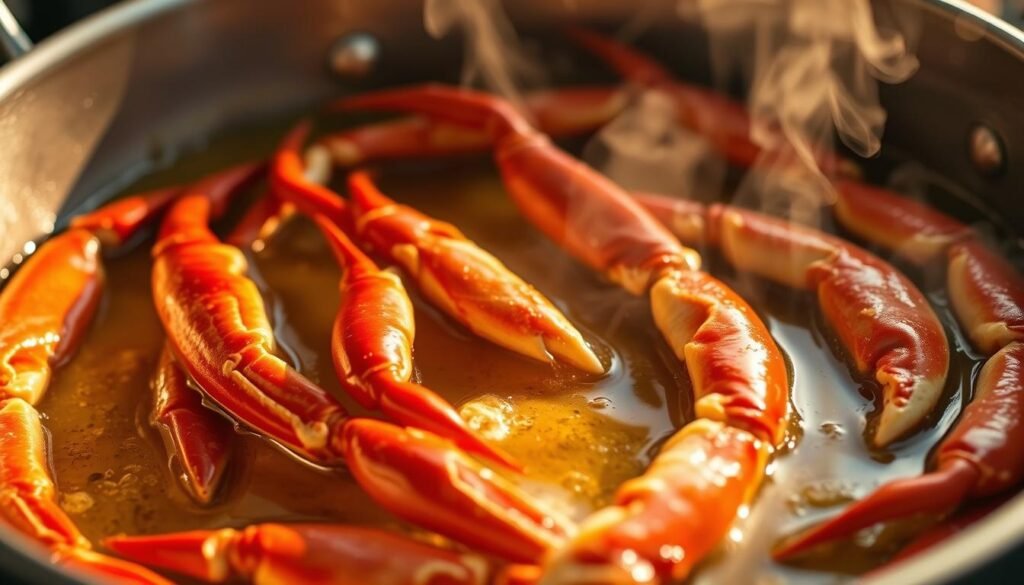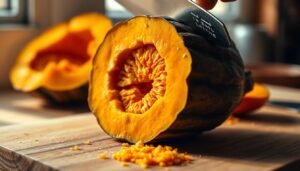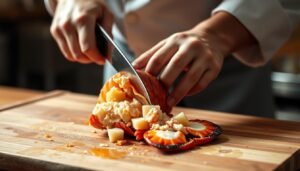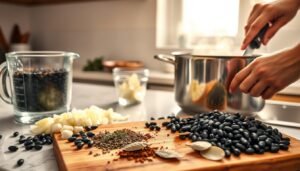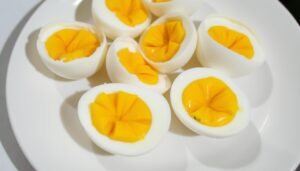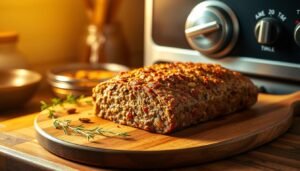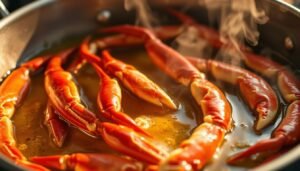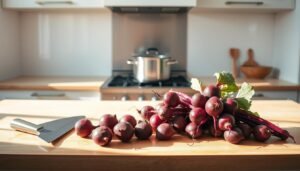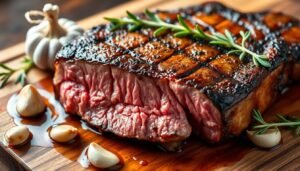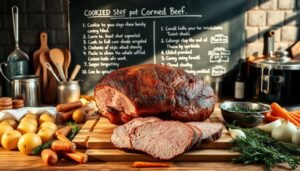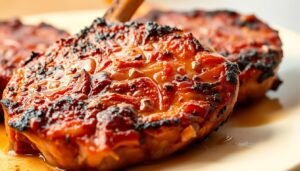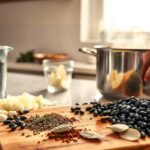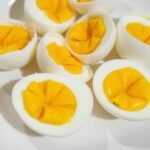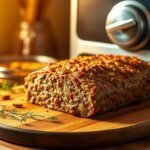Did you know America eats over 2 million pounds of crab legs each year? This shows how much we love this tasty seafood. If you enjoy crab legs but are scared to cook them, I’m here to help. You can make delicious crab legs at home in under 10 minutes with my easy recipes and tips.
The secret to great flavor and texture is in how you cook them. Make sure not to overcook, or the meat will become rubbery. This guide will show you simple steps and important tips for cooking crab legs that will impress everyone. So, let’s start and make your next seafood dinner unforgettable!
Key Takeaways
- Cooking crab legs at home is quick and easy.
- They are usually pre-cooked and frozen, so you’re mainly warming them up.
- Common cooking methods include boiling, steaming, and baking.
- Avoid overcooking to prevent rubbery meat.
- This guide offers essential tips for delicious results.
Understanding Different Types of Crab Legs
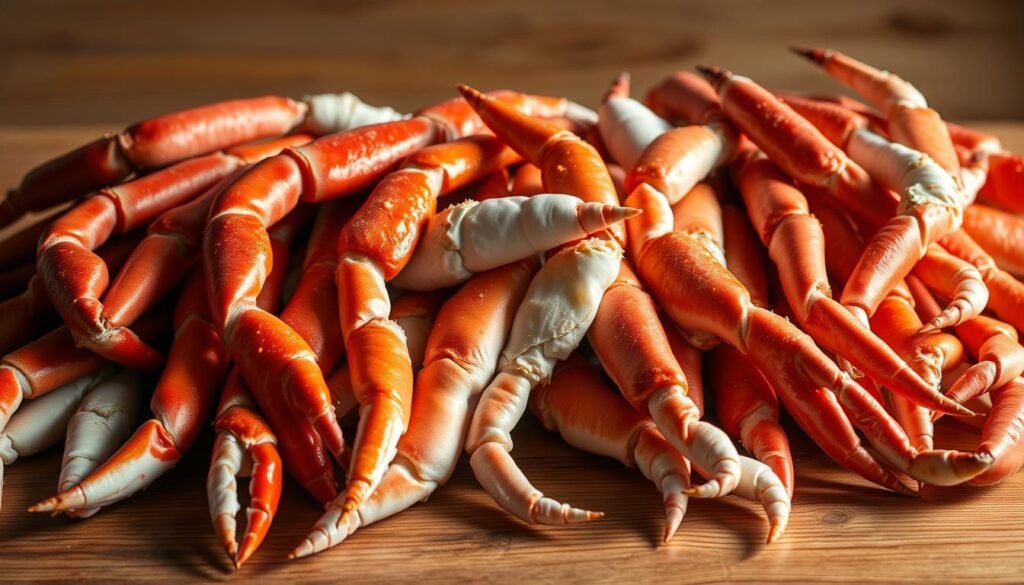
There are many types of crab legs to try, each with its own taste and texture. We’ll look at king crab, snow crab, and dungeness crab. Knowing about these varieties can make your meals more exciting.
King Crab vs. Snow Crab
King crab is famous for its large size and rich flavor. It’s tender and tastes like lobster. Snow crab, on the other hand, is cheaper and has a briny taste. Its meat is sweeter but less tender than king crab.
So, it comes down to what you like more: the taste of king crab or the price of snow crab.
Dungeness Crab: A Flavorful Option
Dungeness crab is loved for its mild sweetness and tender meat. It’s perfect for crab boils and feasts. Its flavor can be light or stronger, making it great for many dishes.
The Nutritional Benefits of Crab Legs
Crab legs are good for you if you watch what you eat. They’re full of protein and low in calories. They also have vitamins and minerals like B12, zinc, and selenium.
Essential Tools for Cooking Crab Legs
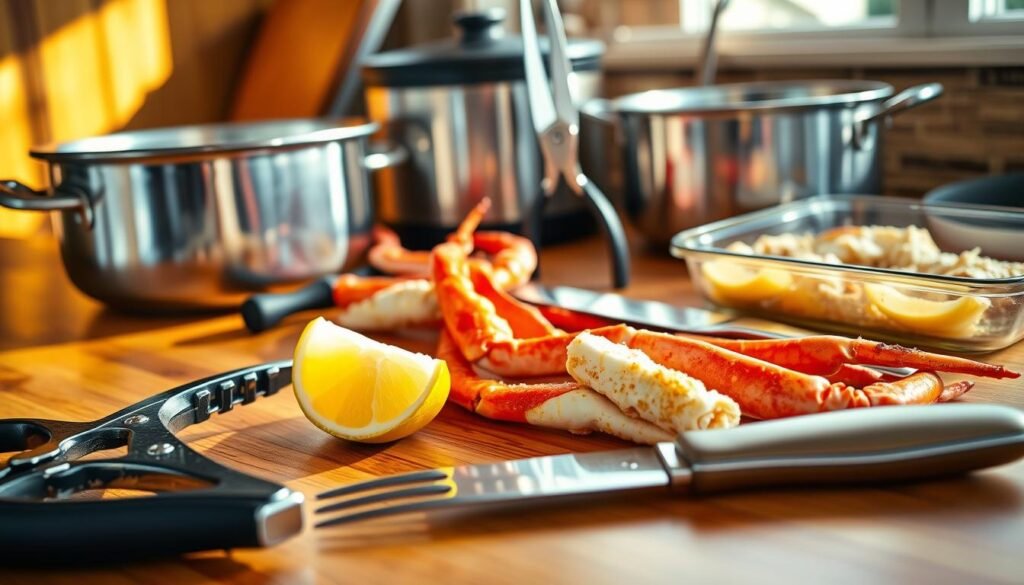
Cooking crab legs can be a fun experience with the right tools. Using the right tools makes cooking easier and the results better. You’ll need pots, utensils, and other kitchen accessories.You can learn more about how to cook beets.
Steamers and Pots: What You Need
A large pot or Dutch oven is best for cooking crab legs. Make sure it’s big enough for the crab legs to fit well. For steaming, a good steamer basket is key. It helps cook the crab evenly and keeps its flavor.
Here’s a quick look at the two options:
| Cooking Method | Pots | Steamers |
|---|---|---|
| Best for | Boiling crab legs | Steaming crab legs |
| Flavor Retention | Moderate | High |
| Ease of Use | Easy | Very Easy |
Kitchen Utensils for Handling Crab Legs
For crab cooking, you need the right utensils. You’ll need:
- Crab crackers for breaking open hard shells
- Seafood forks to extract sweet meat effortlessly
- Tongs for safely handling hot crab legs
- Brush for spreading melted butter
These tools make cooking crab legs easier and more fun.
Optional Tools for the Perfect Feast
For a better crab cooking experience, consider these optional tools. A meat thermometer ensures the crab is cooked just right. Other great additions include:
- A large serving platter for an impressive presentation
- Butter warmers to keep melted butter at the perfect temperature
- Sea salt or seasoning shakers for quick seasoning options
Preparing Your Crab Legs for Cooking
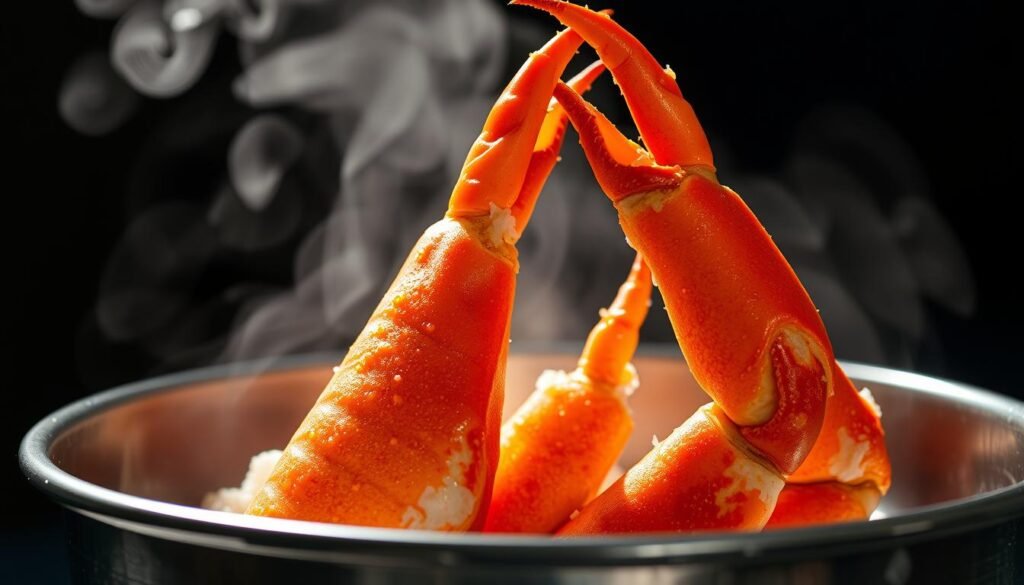
Getting your crab legs ready is key to a tasty meal. Whether you have frozen or fresh crab, knowing how to thaw and clean them is important. It makes a big difference in how your dish turns out.
Thawing Frozen Crab Legs
Thawing crab legs in the fridge overnight is best. It defrosts them slowly, keeping them tender. If you’re short on time, thaw them in cold water for 30 minutes. But always thaw them properly to avoid tough meat.You can learn more about how to cook chicken breast.
Cleaning and Preparing Fresh Crab Legs
Start by rinsing fresh crab legs under cold water. This removes sand or debris. While cleaning, check for any shell pieces. Cleaning them well makes your meal more enjoyable and brings out the fresh flavor.
Boiling Crab Legs: A Step-by-Step Guide
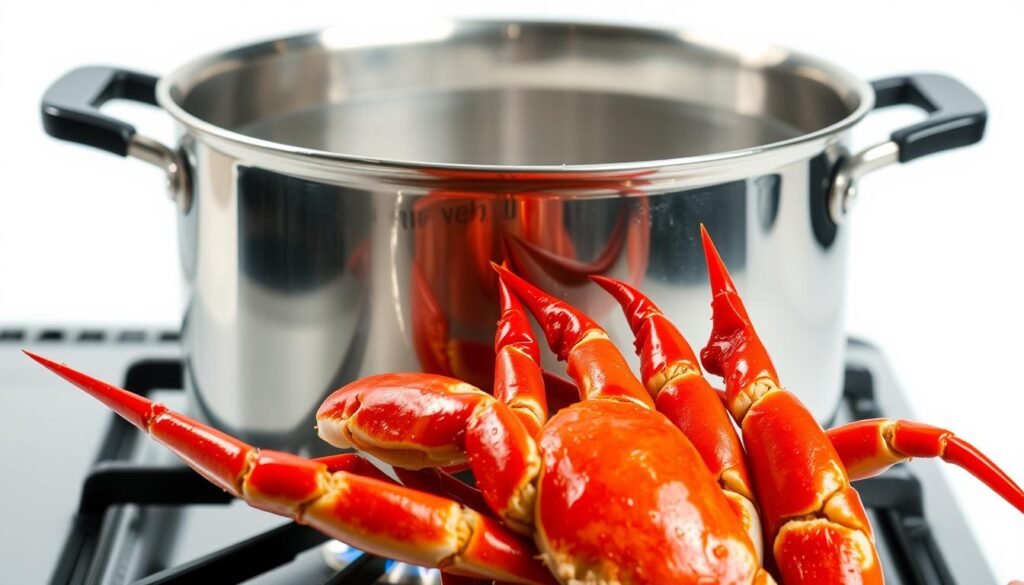
Boiling crab legs is easy and makes them taste great. The secret is in the boiling water and cooking times. I’ll show you how to cook crab legs perfectly in a few steps.
Preparing the Boiling Water
I start by filling a big pot with water and add lots of salt for flavor. I also toss in spices like Old Bay for extra taste. Then, I bring the water to a boil.
Cooking Time for Different Types of Crab
When the pot is hot, I add the crab legs. They need to be fully covered. Cooking times vary for pre-cooked and frozen legs. Pre-cooked legs simmer for 5 to 8 minutes. Frozen ones take 10 to 12 minutes. It’s important to watch them to avoid overcooking.You can learn more about how to cook broccoli.
Flavoring Your Boil with Seasonings
Want to add more flavor? Try lemon slices, garlic, or bay leaves to the water. These add a rich taste to the crab. You can change the flavors each time, making it a great dish for any event.
Steaming Crab Legs: A Flavorful Option
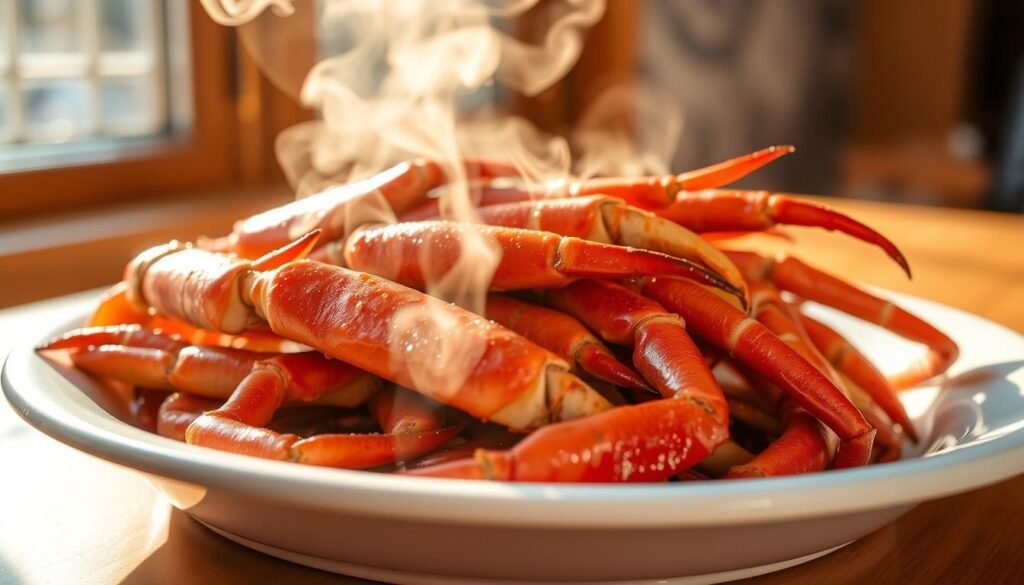
Steaming crab legs is a delicate way to enjoy this seafood treat. It keeps their juices in, making each bite satisfying. Knowing how to steam them right is key to tender, tasty results.
Setting Up Your Steamer
Start by filling a big pot with about an inch of water. Place a steamer basket above it. Boil the water before adding the crab legs. Put the legs in the basket and cover the pot to keep the steam in.
This method cooks the legs evenly and brings out their flavor.
Cooking Times and Tips
Steaming crab legs takes 8 to 10 minutes, depending on their size. Check them halfway to ensure even cooking. Adding garlic and lemon to the water can make them taste even better.
Enhancing Steamed Crab with Butter
After steaming, serve the crab legs with melted butter. A sprinkle of paprika or fresh herbs can make it even better. Dipping in butter is a joy that matches the crab’s sweetness. For more steaming tips, check out this guide.
Enjoy your steamed crab legs, where each bite is a burst of flavor. It’s a taste of the sea that will leave you wanting more!
Grilling Crab Legs: A Unique Twist
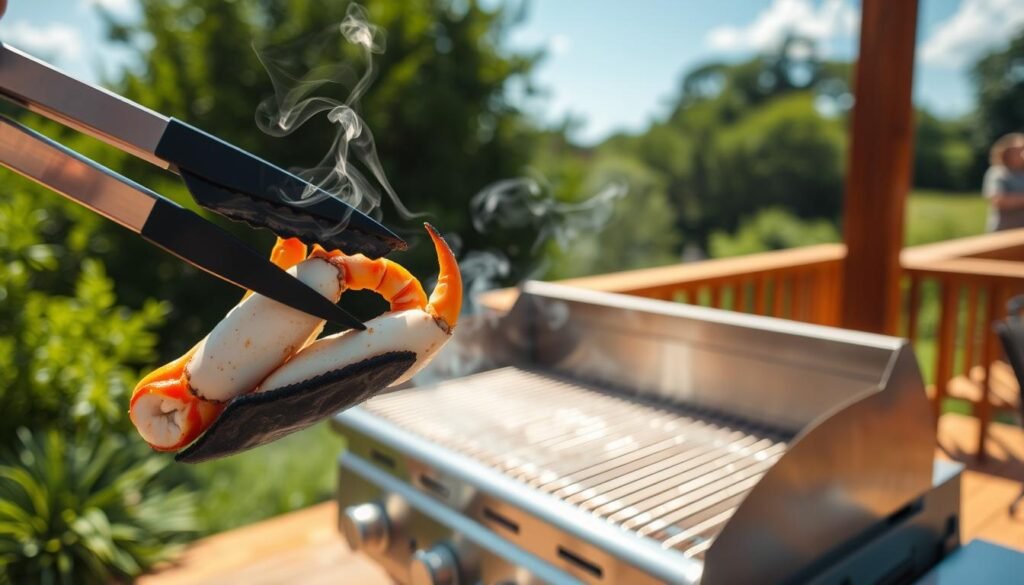
Grilling crab legs adds a smoky flavor that brings out their sweetness. It’s a great way to enjoy them during summer. Learning how to grill them right makes the process fun and easy.
Prepping Crab Legs for the Grill
First, heat your grill to medium-high. While it warms up, brush the crab legs with melted butter or oil. This adds moisture and flavor, making them taste amazing.
Marinades and Seasoning Suggestions
Marinades can really make your crab legs stand out. I like to mix different spices and herbs. A classic mix is garlic, lemon juice, and Old Bay seasoning. You can add your favorite flavors to make a marinade that you’ll love.
Cooking Techniques for Grilled Crab
Place the crab legs on the grill and cook for 8-10 minutes. Flip them halfway for even cooking. For more details, check out how to grill crab legs. This method gives you a grilled outside and tender inside.
Baking Crab Legs: Easy and Delicious
Baking crab legs is a simple way to get a tasty and juicy meal. It’s perfect for any occasion, whether it’s a big gathering or a quiet dinner. I always preheat my oven to 375°F (190°C) for the best results.
Setting the Oven Temperature
It’s important to preheat the oven when baking crab legs. A temperature of 375°F is ideal for tender, juicy meat. This temperature helps the flavors come together, making the dish delicious.
Wrapping Techniques for Juicy Results
I use a lined baking sheet and sometimes wrap the crab legs in foil. Wrapping them keeps the moisture in and prevents drying. This method ensures the crab stays juicy.
Baking Times for Perfectly Cooked Crab
The baking time for crab legs depends on the type of crab. Usually, 15 to 25 minutes is enough, depending on the size. For more tips, check out my favorite resource here.
Serving Suggestions for Crab Legs
Serving crab legs can be made special with a few simple touches. I love adding melted garlic butter, lemon wedges, and tasty dipping sauces. Fresh herbs can also brighten up your dish, adding color and freshness.
Classic Pairings: Dips and Sides
Choosing the right dips is key to enjoying crab legs. Creamy aioli and zesty cocktail sauce are favorites. Here are some tasty sides I often serve:
- Roasted or boiled baby potatoes seasoned with herbs
- Corn on the cob drizzled with seasoned butter
- Mac and cheese made with sharp cheese for a comforting touch
- Sweet potato fries that add a touch of sweetness
- Refreshing coleslaw to balance the richness of the crab
Plating Your Crab Legs for Presentation
A beautifully plated dish is more than just tasty; it’s also a work of art. I arrange crab legs on a platter with parsley or lemon slices. This makes the meal look fancy, great for when you’re hosting.
For more ideas on how to present your dish, check out these serving ideas.
Creative Recipes Featuring Crab Legs
Exploring new recipes can lead to amazing dishes. Crab can be used in elegant salads or pasta dishes. Its versatility lets me create unique and delicious meals every time.
Troubleshooting Common Cooking Issues
Cooking crab legs can sometimes lead to a few unexpected challenges, but understanding these issues will help me achieve delicious results. One common problem I encounter is the difference between overcooked and undercooked crab legs. Overcooking makes the meat tough and rubbery, while undercooking can leave me with unsafe crab that may harbor bacteria. To avoid both, I pay close attention to the recommended cooking times for each method.
If I find myself with rubbery crab meat, there are ways to salvage the dish. A moist cooking technique, like steaming with butter, can work wonders for fixing crab meat’s texture. It reintroduces moisture and adds flavor, making it worth a try if I’m in this predicament. For more detailed insights into this process, I often refer to expert advice available here: cooking crab legs chef mistakes.
After enjoying crab legs, I always think about storing crab leftovers properly to maintain their quality. I ensure to keep them in their shells, packed in an airtight container to preserve the flavor and moisture—making sure to consume them within a few days. Following these tips makes my crab culinary experience rewarding, avoiding crab leg cooking issues and maximizing enjoyment on my plate.


